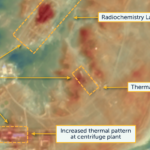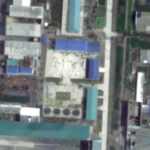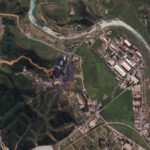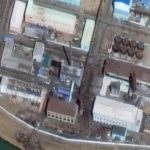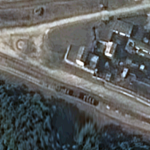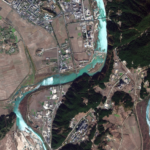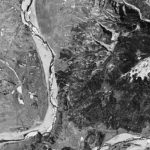April 15, 2021, by Joseph S. Bermudez Jr., Victor Cha, Andy Dinville and Dana Kim—
Recently acquired LANDSAT 7 and 8 thermal infrared imagery of the Yongbyon Nuclear Research Center provide strong indications that during March and April 2021, activity involving the heating of buildings and operations of facility support systems had resumed at several locations.
These indications reveal clear patterns, distinct from the surrounding terrain and daily solar heating patterns, that suggest that the Radiochemistry Laboratory, its associated thermal plant, and the centrifuge plant resumed operations during the early part of March 2021 and have continued into mid-April 2021.
March 30, 2021, by Joseph S. Bermudez Jr. and Victor Cha—
At the Yongyon Radiochemistry Laboratory, steam (or smoke) rising from any of the stacks within the radiochemistry laboratory itself is not often observed in commercial satellite imagery. However, the March 30 image shows a plume of steam or smoke emanating from a small support building in the center of the facility. This, while not an indicator of a reprocessing campaign itself, indicates that the building is occupied and being heated.
March 26, 2021, by Joseph S. Bermudez Jr., Victor Cha and Dana Kim—
Commercial satellite imagery collected during the past eight months indicates that despite the absence of any nuclear testing by North Korea since 2017, the Pyongsan Uranium Concentrate Plant remains operational, is producing uranium concentrate (U3O8, “yellowcake”), and continues to be updated. Yellowcake can be enriched to become highly enriched uranium (HEU), which can be used to produce nuclear weapons.
September 8, 2020, by Joseph S. Bermudez Jr. and Dana Kim—
The Hungnam Fertilizer Complex has long been associated with producing chemical feed stocks or agents for North Korea’s nuclear weapons, chemical weapons and ballistic missile programs. Any modernization or improvement in its production capacities warrant close monitoring as they have the potential to support or augment WMD capabilities.
August 27, 2020, by Joseph S. Bermudez Jr., Victor Cha and Bonny Lee—
The Pyongsan Uranium Concentrate Plant represents a critical component of North Korea’s nuclear research and weapons development programs. Through analysis of 100+ medium- and high-resolution declassified and commercial satellite images, this report aims to provide a new and unique look into the facility. It is also the second publication in a series analyzing North Korea’s uranium concentrate plants as well as one of the most comprehensive collections of unclassified information and satellite imagery presently available of the Pyongsan facility.
May 29, 2020, by Joseph S. Bermudez Jr. and Victor Cha—
The Pyongsan Uranium Concentrate Plant (38.318369 N, 126.432360 E) is located in Pyongsan-gun (평산군, Pyongsan County), Hwangbuk-do (황북, North Hwanghae Province), approximately 45 kilometers from the DMZ and 96 kilometers northwest of Seoul—the capital of South Korea. Since approximately 1990 it has occupied an critical role in the Democratic People’s Republic of Korea’s (North Korea) nuclear research and weapons programs as the sole known provider of uranium oxide (yellowcake) to these programs for fuel fabrication or enrichment.
February 14, 2020, by Joseph S. Bermudez Jr. and Victor Cha—
Satellite imagery acquired on February 14, 2020 shows that the three specialized railcars identified in Beyond Parallel’s report from February 11, 2020 have been moved from west of the Radiochemistry Laboratory to the southern rail yard adjacent to the reported isotope/tritium production facility.
A fourth railcar is present in the latest imagery in addition to the three railcars that were captured in imagery from February 10, 2020.
These railcars have been associated with the movement of radioactive material in the past.
If past practice is any indication, all four cars will leave the Yongbyon facility sometime during the next seven days.
February 11, 2020, by Joseph S. Bermudez Jr. and Victor Cha—
Satellite imagery acquired on February 10, 2020 shows the presence of three specialized railcars that have been associated with the movement of radioactive material in the past. The last observed presence of these railcars by Beyond Parallel was in November 2019.
The size and number of the casks observed on the railcars suggest the outbound shipment of irradiated liquid or solid waste, disassembled but contaminated equipment or, potentially, the movement of fissile materials. A less likely alternative is the inbound shipment of radioactive material.
November 14, 2019, by Joseph S. Bermudez Jr., Victor Cha and Dana Kim—
Recent satellite imagery from November 2019 shows the presence of four specialized railcars that have been associated with the movement of radioactive material in the past. The last observed movement of these railcars by Beyond Parallel was in April 2019. It is unclear whether the railcars are being used for the outbound shipment of irradiated liquid or solid waste, disassembled but contaminated equipment or the movement of fissile material to facilities outside the Yongbyon area. A less likely alternative is the inbound shipment of radioactive material from a facility outside the Yongbyon area.
October 22, 2019, by Joseph S. Bermudez Jr.—
Collected 14 months after the image provided in Part 5 (November 21, 1968) this March 17, 1970 KH-4B image of the Yongbyon Nuclear Research Center shows continued expansion within the village of Sang-dong, minor improvements in the operations, administration/laboratory and support areas, slowly continuing construction of the bridge across the Kuryong-gang and minor infrastructure improvements in the Pungang-ni area. Taken as a whole, these developments continue to indicate an ongoing first-phase construction project for the facility and very early infrastructure development efforts within a longer-term plan for future expansion.
